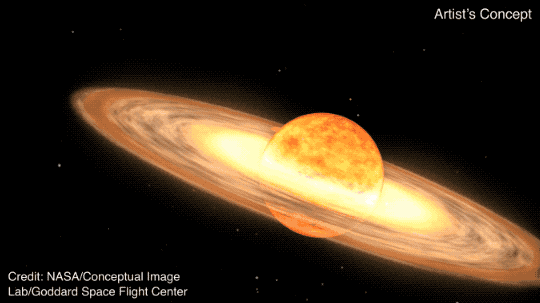Astrophysics
James Webb's Newest Image Shows a Giant Penguin and an Egg
NASA released the dazzling portrait to help celebrate the two-year anniversary of the release of Webb's first images
A 'Major Lunar Standstill' Is Happening This Year—and Friday's Full Moon Offers 'Dramatic' View
From now through much of next year, the moon will periodically rise and set at its most extreme points, thanks to a rare celestial phenomenon that only occurs every 18.6 years
This Giant Cosmic 'Butterfly' Is a Planet-Forming Disk
New research has confirmed that the celestial object may be the biggest of its kind ever found
See Five Dazzling New Images of the Cosmos, Captured by Europe's Space Telescope
With its visible and infrared photography, Euclid—known as the "dark universe detective"—is helping astronomers better understand dark matter and dark energy
James Webb Telescope Detects Earliest Known Black Hole Merger, Just 740 Million Years After the Big Bang
The new observations could help explain how black holes became so massive in the early universe
Where Do We Get Seeds for Seedless Fruit? And More Questions From Our Readers
You’ve got questions. We’ve got experts
Astronomers Discover an Atmosphere on a Hot, Rocky Exoplanet With an Ocean of Magma
It's the best evidence yet of an atmosphere on a rocky planet outside our solar system, researchers say, and studying the distant world could provide insight into Earth’s early days
A Rare Nova Explosion Will Soon Bring a 'New Star' to the Night Sky—How to Catch a Glimpse
In an event that occurs only once every 80 years, a distant remnant of a star will grow much brighter, briefly becoming visible to Earth
Dark Energy Could Be Evolving Over Time, Raising Questions About the Nature of the Cosmos
The largest 3D map of the universe ever made hints that dark energy might not be a constant, though the findings must be backed up with more data
This Is the Gear You Need to View the 2024 Total Solar Eclipse
Protect your eyesight with eclipse glasses, binoculars, telescopes or lens filters
Astronomers Capture Dazzling New Image of the Black Hole at the Milky Way's Center
The first image of the black hole taken in polarized light, the new view shows the supermassive structure's magnetic fields and hints that it could be hiding an enormous jet
How Ancient Texts Can Shed Light on Auroras
Documenting episodes of the phenomenon thousands of years ago may help us predict damaging solar storms in the future
Astronomers Discover the Brightest Known Object in the Universe, Shining 500 Trillion Times as Bright as the Sun
The quasar—a glowing, active core of a galaxy—has a black hole at its center that consumes more than a sun’s-worth of mass each day
This 'Game-Changer' Detector Will Hunt for Giant Ripples in Spacetime
Set to launch in 2035, the European Space Agency's LISA mission will listen for gravitational waves created by colliding black holes and neutron stars—and some might date nearly to the Big Bang
Giant, 'Odd' Circles of Radio Waves in Space May Finally Have an Explanation
The mystifying orbs could be caused by galactic winds, propelled by a period of rapid star formation and death
Astronomers Discover the Oldest Known Black Hole, Breaking a Record Set Last Year
The supermassive structure dates to about 400 million years after the Big Bang, and it’s particularly large for its age
This Distant Exoplanet Has a 350,000-Mile-Long Tail, Like a Comet
A stream of particles flung from the planet's star is causing its atmosphere to boil away and lose 200,000 tons of mass per second
Astronomers Discover Rare Solar System Where Planets Orbit in Mathematical Harmony
The "resonant" planets could provide insight about how such systems form and evolve—and why our own solar system is not synced up
Scientists Mystified by Rare, High-Energy Cosmic Ray, the Most Powerful Since 1991
Researchers have been unable to locate an obvious source for the particle—it seems to have traveled from an empty spot in space
Astronomers Spot the Oldest Black Hole Ever Seen, Shedding Light on the Early Universe
Dating to just 470 million years after the Big Bang, the ancient cosmic structure could help researchers understand how the first black holes formed
Page 1 of 14
:focal(2139x1354:2140x1355)/https://tf-cmsv2-smithsonianmag-media.s3.amazonaws.com/filer_public/94/63/9463bb82-fefa-4419-ab97-22b5c6033587/interacting_galaxies_arp_142_nircam_and_miri_image.jpg)
:focal(1920x1280:1921x1281)/https://tf-cmsv2-smithsonianmag-media.s3.amazonaws.com/filer_public/05/91/059191fc-b3c1-406b-89c0-27f492723ceb/pexels-peter-de-vink-288978-975012.jpg)
:focal(1800x1029:1801x1030)/https://tf-cmsv2-smithsonianmag-media.s3.amazonaws.com/filer_public/ac/67/ac6788b0-1d73-44f2-b968-a319ff7679e3/bigger_main_image_large.jpg)
:focal(4100x4100:4101x4101)/https://tf-cmsv2-smithsonianmag-media.s3.amazonaws.com/filer_public/41/9c/419c9894-6994-4251-83d5-8b16b640ac3b/euclid_s_new_image_of_star-forming_region_messier_78.jpg)
:focal(2000x2000:2001x2001)/https://tf-cmsv2-smithsonianmag-media.s3.amazonaws.com/filer_public/bb/6b/bb6bbcb6-6fa9-4c05-bca7-0c89fd918087/weic2413a.jpg)
:focal(760x572:761x573)/https://tf-cmsv2-smithsonianmag-media.s3.amazonaws.com/filer_public/87/3e/873eb70d-b8b7-4124-b9b2-67618bf74381/ask.jpg)
:focal(1000x571:1001x572)/https://tf-cmsv2-smithsonianmag-media.s3.amazonaws.com/filer_public/fc/90/fc9022fc-7d85-4a46-9b9c-826922f39b14/stsci-01hwqz4bjsgtdzc7fpdtvtnztc.jpg)

:focal(2000x1200:2001x1201)/https://tf-cmsv2-smithsonianmag-media.s3.amazonaws.com/filer_public/ea/d8/ead81125-df3b-468c-9cb9-804b41f8e3ab/noirlab2408b.jpg)
:focal(2377x1607:2378x1608)/https://tf-cmsv2-smithsonianmag-media.s3.amazonaws.com/filer_public/6c/55/6c556cbf-d7c6-43ac-bd2f-b3f9d47605f6/gettyimages-836328338.jpg)
:focal(1000x1000:1001x1001)/https://tf-cmsv2-smithsonianmag-media.s3.amazonaws.com/filer_public/05/fd/05fd3550-7ef1-46e3-9229-188eb270a02b/sgra_polarimetric_press_image-032724-lores.jpg)
:focal(800x602:801x603)/https://tf-cmsv2-smithsonianmag-media.s3.amazonaws.com/filer_public/72/ba/72ba90f4-730a-47b5-acd1-80a445b88a52/aurora_nagoya_1770_web.jpg)
:focal(2093x1316:2094x1317)/https://tf-cmsv2-smithsonianmag-media.s3.amazonaws.com/filer_public/01/22/0122eed6-f4f1-41e4-bca4-5e359ed38826/eso2402a.jpg)
:focal(768x432:769x433)/https://tf-cmsv2-smithsonianmag-media.s3.amazonaws.com/filer_public/90/e3/90e3d1e3-4331-4a52-a628-a6fba5ba4d3d/lisa-2arms-gws-red2.webp)
:focal(600x314:601x315)/https://tf-cmsv2-smithsonianmag-media.s3.amazonaws.com/filer_public/de/ff/deffd688-64ab-4290-84f8-36ae918f4e44/orc_teaser_1.png)
:focal(640x366:641x367)/https://tf-cmsv2-smithsonianmag-media.s3.amazonaws.com/filer_public/60/33/603333f8-6856-4707-a8f4-5e3cb7da0640/gsfc_20171208_archive_e000402orig.jpg)
:focal(585x435:586x436)/https://tf-cmsv2-smithsonianmag-media.s3.amazonaws.com/filer_public/9b/63/9b635373-2c2b-4c20-9ca4-8f236a148240/hotplanettailmain.jpg)
:focal(1500x1000:1501x1001)/https://tf-cmsv2-smithsonianmag-media.s3.amazonaws.com/filer_public/d7/bc/d7bcd18a-17e2-46e6-b97f-a20f60f18bf5/illustration_orbit-geometry_credit-thibaut-roger-nccr-planets_1.jpg)
:focal(600x343:601x344)/https://tf-cmsv2-smithsonianmag-media.s3.amazonaws.com/filer_public/9d/16/9d167cca-0231-4d6d-8cf4-00e75ce1e72b/fig1_shower_header.jpg)
:focal(1500x1143:1501x1144)/https://tf-cmsv2-smithsonianmag-media.s3.amazonaws.com/filer_public/32/59/32593cc4-b6e9-4025-8431-6231b3459423/uhz1.jpg)